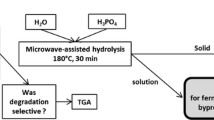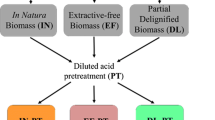Abstract
Lignocellulosic biomass is hardly degraded during anaerobic digestion. Among a large panel of pretreatments used to improve the biodegradability of this substrate, alkaline pretreatments are recognized as the most efficient to remove lignin and therefore improve the methane production of these substrates. This article uses different histological stains (FASGA, phloroglucinol, Mäule reagent, Congo red), immunolocalization, and histological quantification on pretreated internode stem tissue section in order to decipher the mechanism of alkaline pretreatment action (CaO and NaOH) in the anatomical and lignocellulosic matrix scale of Sorghum Biomass 140 hybrid and of Miscanthus × giganteus Floridulus. A significant delignification of all tissues was observed (sclerenchyma, parenchyma, and xylem) except in the epidermis and in the internal part of the perivascular sclerenchyma. The degradation of lignin under the effect of alkaline pretreatment is accompanied by a massive unmasking of cellulose and a reduction of crystalline cellulose. This induced an increase of anaerobic digestion kinetics for both biomass and of methane yield for miscanthus. Miscanthus is rich in G-type lignins located mainly at the level of the perivascular sclerenchyma of the external internode zone which was more degraded by alkalies than the S-type lignin; this may explain the improvement of miscanthus methane potential.







Similar content being viewed by others
Data Availability
The authors will make data available on request.
Code Availability
Not applicable.
References
Ghatak HR (2011) Biorefineries from the perspective of sustainability: feedstocks, products, and processes. Renew Sustain Energy Rev 15:4042–4052. https://doi.org/10.1016/j.rser.2011.07.034
Arnoult S, Obeuf A, Béthencourt L et al (2015) Miscanthus clones for cellulosic bioethanol production: relationships between biomass production, biomass production components, and biomass chemical composition. Ind Crops Prod 63:316–328. https://doi.org/10.1016/j.indcrop.2014.10.011
Monk RL, Miller FR, McBee GG (1984) Sorghum improvement for energy production. Biomass 6:145–153. https://doi.org/10.1016/0144-4565(84)90017-9
Scheller HV, Pauly M, Loque D (2015) Engineering of plant cell walls for enhanced biofuel production. Plant Biol 25:151–161. https://doi.org/10.1016/j.pbi.2015.05.018
Mcfarlane HE, Anett D (2014) The cell biology of cellulose synthesis. Annu Rev Plant Biol 65:69–94. https://doi.org/10.1146/annurev-arplant-050213-040240
Pauly M, Gille S, Liu L et al (2013) Hemicellulose biosynthesis. Planta 238(4):627–642. https://doi.org/10.1007/s00425-013-1921-1
Pu Y, Zhang D, Singh PM, Ragauskas AJ (2008) The new forestry biofuels sector 2:58–73. https://doi.org/10.1002/bbb
Zheng Y, Zhao J, Xu F, Li Y (2014) Pretreatment of lignocellulosic biomass for enhanced biogas production. Prog Energy Combust Sci 42:35–53. https://doi.org/10.1016/j.pecs.2014.01.001
Vanholme R, Demedts B, Morreel K et al (2010) Lignin biosynthesis and structure 1. Plant Physiol 153:895–905. https://doi.org/10.1104/pp.110.155119
Baucher M, Monties B, Van MM, Boerjan W (1998) Biosynthesis and genetic engineering of lignin biosynthesis and genetic engineering of lignin. CRC Crit Rev Plant Sci 17:125–197
Wertz J-L, Bédué O (2013) Lignocellulosic biorefineries
Monlau F, Barakat A, Trably E et al (2013) Lignocellulosic materials into biohydrogen and biomethane: impact of structural features and pretreatment. Crit Rev Environ Sci Technol 43:260–322. https://doi.org/10.1080/10643389.2011.604258
Kikas T, Tutt M, Raud M et al (2016) Basis of energy crop selection for biofuel production : cellulose vs. lignin. Int J Green Energy 13(1):49–54. https://doi.org/10.1080/15435075.2014.909359
Karimi K, Shafiei M, Kumar R (2013) Progress in physical and chemical pretretment of lignocellulosic biomass
Bichot A, Delgenès J-P, Méchin V et al (2018) Understanding biomass recalcitrance in grasses for their efficient utilization as biorefinery feedstock. Rev Environ Sci Bio/Technology 17:707–748. https://doi.org/10.1007/s11157-018-9485-y
Ravindran R, Jaiswal AK (2016) A comprehensive review on pre-treatment strategy for lignocellulosic food industry waste: challenges and opportunities. Bioresour Technol. https://doi.org/10.1016/j.biortech.2015.07.106
Rollin JA, Zhu Z, Sathitsuksanoh N, Zhang YP (2011) Increasing cellulose accessibility is more important than removing lignin : a comparison of cellulose solvent-based lignocellulose fractionation and soaking in aqueous ammonia. Biotechnol Bioeng 108:22–30. https://doi.org/10.1002/bit.22919
Monlau F, Sambusiti C, Barakat A et al (2012) Predictive models of biohydrogen and biomethane production based on the compositional and structural features of lignocellulosic materials. Environ Sci Technol 46:12217–12225. https://doi.org/10.1021/es303132t
Carrere H, Antonopoulou G, Affes R et al (2016) Review of feedstock pretreatment strategies for improved anaerobic digestion: from lab-scale research to full-scale application. Bioresour Technol 199:386–397. https://doi.org/10.1016/j.biortech.2015.09.007
Monlau F, Barakat A, Steyer JP, Carrere H (2012) Comparison of seven types of thermo-chemical pretreatments on the structural features and anaerobic digestion of sunflower stalks. Bioresour Technol 120:241–247. https://doi.org/10.1016/j.biortech.2012.06.040
Talebnia F, Karakashev D, Angelidaki I (2010) Production of bioethanol from wheat straw: an overview on pretreatment, hydrolysis and fermentation. Bioresour Technol 101:4744–4753. https://doi.org/10.1016/j.biortech.2009.11.080
Hernández-Beltrán JU, Hernández-De Lira IO, Cruz-Santos MM et al (2019) Insight into pretreatment methods of lignocellulosic biomass to increase biogas yield: current state, challenges, and opportunities. Appl Sci 9:3721. https://doi.org/10.3390/app9183721
Thomas HL, Arnoult S, Brancourt-hulmel M, Carrère H (2019) Methane production variability according to miscanthus genotype and alkaline pretreatments at high solid content. BioEnergy Res 12:325–337. https://doi.org/10.1007/s12155-018-9957-5
Li M, Si S, Hao B et al (2014) Mild alkali-pretreatment effectively extracts guaiacyl-rich lignin for high lignocellulose digestibility coupled with largely diminishing yeast fermentation inhibitors in Miscanthus. Bioresour Technol 169:447–454. https://doi.org/10.1016/j.biortech.2014.07.017
Sambusiti C, Ficara E, Malpei F et al (2013) Effect of sodium hydroxide pretreatment on physical, chemical characteristics and methane production of five varieties of sorghum. Energy 55:449–456. https://doi.org/10.1016/j.energy.2013.04.025
Nkongndem Nkemka V, Yongqiang L, Hao X (2016) Effect of thermal and alkaline pretreatment of giant miscanthus and Chinese fountaingrass on biogas production. Water Sci Technol 73(4):849–856. https://doi.org/10.2166/wst.2015.559
Karimi K, Taherzadeh MJ (2016) A critical review of analytical methods in pretreatment of lignocelluloses: composition, imaging, and crystallinity. Bioresour Technol 200:1008–1018. https://doi.org/10.1016/j.biortech.2015.11.022
Thomas HL, Pot D, Latrille E et al (2019) Sorghum biomethane potential varies with the genotype and the cultivation site. Waste and Biomass Valorization 10:783–788. https://doi.org/10.1007/s12649-017-0099-3
Sambusiti C, Ficara E, Malpei F et al (2012) Influence of alkaline pre-treatment conditions on structural features and methane production from ensiled sorghum forage. Chem Eng J 211–212:488–492. https://doi.org/10.1016/j.cej.2012.09.103
Pomar F, Merino F, Barceló AR (2002) O-4-linked coniferyl and sinapyl aldehydes in lignifying cell walls are the main targets of the Wiesner (phloroglucinol-HCl) reaction. Protoplasma 220:17–28. https://doi.org/10.1007/s00709-002-0030-y
Iiyama K, Pant R (1988) The mechanism of the Mäule colour reaction introduction of methylated syringyl nuclei into softwood lignin. Wood Sci Technol 22:167–175. https://doi.org/10.1007/BF00355852
Blake AW, McCartney L, Flint JE et al (2006) Understanding the biological rationale for the diversity of cellulose-directed carbohydrate-binding modules in prokaryotic enzymes. J Biol Chem 281:29321–29329. https://doi.org/10.1074/jbc.M605903200
Hernandez-Gomez MC, Rydahl MG, Rogowski A et al (2015) Recognition of xyloglucan by the crystalline cellulose-binding site of a family 3a carbohydrate-binding module. FEBS Lett 589:2297–2303. https://doi.org/10.1016/j.febslet.2015.07.009
Perrier L, Rouan L, Jaffuel S et al (2017) Plasticity of sorghum stem biomass accumulation in response to water deficit : a multiscale analysis from internode tissue to plant level 8:1–14. https://doi.org/10.3389/fpls.2017.01516
APHA American Public Health Association (1998) Standard methods for the examination of water and wastewater
A. Sluiter, B. Hames, R. Ruiz, et al (2011) Determination of structural carbohydrates and lignin in biomass laboratory analytical procedure (LAP)
Tukey J (1949) Comparing individual means in the analysis of variance. Biometrics 5(2):99–114
Kaack K, Schwarz KU, Brander PE (2003) Variation in morphology, anatomy and chemistry of stems of Miscanthus genotypes differing in mechanical properties. Ind Crops Prod 17:131–142. https://doi.org/10.1016/S0926-6690(02)00093-6
Ji Z, Zhang X, Ling Z et al (2016) Tissue specific response of Miscanthus × giganteus to dilute acid pretreatment for enhancing cellulose digestibility. Carbohydr Polym 154:247–256. https://doi.org/10.1016/j.carbpol.2016.06.086
Boon EJM, Struick P, Tamminga S et al (2008) Stem characteristics of two forage maize ( Zea mays L.) cultivars varying in whole plant digestibility. III. Intra-stem variability in anatomy, chemical composition and in vitro rumen fermentation. NJAS - Wageningen J Life Sci 56:101–122. https://doi.org/10.1016/S1573-5214(08)80019-X
Sun L, Li C, Xue Z et al (2013) Unveiling high-resolution, tissue specific dynamic changes in corn stover during ionic liquid pretreatment. RSC Adv 3:2017–2027. https://doi.org/10.1039/c2ra20706k
Villaverde JJ, Li J, Ek M et al (2009) Native Lignin structure of miscanthus x giganteus and its changes during acetic and formic acid fractionation. J Agric Food Chem 57:6262–6270. https://doi.org/10.1021/jf900483t
Reina-Pinto JJ, Yephremov A (2009) Surface lipids and plant defenses. Plant Physiol Biochem 47:540–549. https://doi.org/10.1016/j.plaphy.2009.01.004
Kolattuduky P (2001) Polyesters in higher plants. Advances in Biochemical Engineering/Biotechnology
Yeats TH, Rose JKC (2013) Topical review on cuticle synthesis and function the formation and function of plant cuticles 1. Plant Physiol 163:5–20. https://doi.org/10.1104/pp.113.222737
Norman GL, Michael GP (1989) Plant cell wall polymers, biogenesis and biodegradation
Motte JC, Watteau F, Escudié R et al (2015) Dynamic observation of the biodegradation of lignocellulosic tissue under solid-state anaerobic conditions. Bioresour Technol 191:322–326. https://doi.org/10.1016/j.biortech.2015.04.130
Li M, Yan G, Bhalla A et al (2018) Physical fractionation of sweet sorghum and forage / energy sorghum for optimal processing in a biorefinery Industrial Crops & Products Physical fractionation of sweet sorghum and forage / energy sorghum for optimal processing in a biore fi nery. Ind Crop Prod 124:607–616. https://doi.org/10.1016/j.indcrop.2018.07.002
Li M, Wang J, Yang Y, Xie G (2016) Alkali-based pretreatments distinctively extract lignin and pectin for enhancing biomass saccharification by altering cellulose features in sugar-rich Jerusalem artichoke stem. Bioresour Technol 208:31–41. https://doi.org/10.1016/j.biortech.2016.02.053
Acknowledgements
Particular acknowledgements are addressed to Dr. Arnoult Stéphanie (INRA UE0972 GCIE) and Dr. Pot David (CIRAD-AGAP) who provided the raw miscanthus and sorghum stems, respectively. We thank Bio2E platform (https://doi.org/10.5454/1.557234103446854E12) and the MRI imaging facility, which is part of the UMS BioCampus Montpellier, and a member of the national infrastructure, France-BioImaging (www.mri.cnrs.fr, www.france-bioimaging.org), for providing facilities to perform experiments.
Funding
This work was supported by the project Biomass For the Future from the French National Research Agency (ANR, grant ANR-11-BTBR-0006-BFF).
Author information
Authors and Affiliations
Contributions
Hélène Laurence Thomas: investigation, formal analysis, visualization, conceptualization, writing—original draft.
Helga Felix P. Nolasco: investigation, writing—review and editing.
Hélène Carrère: funding acquisition, conceptualization, supervision, validation, writing—review and editing.
Marc Lartaud: formal analysis, writing—review and editing.
Tuong-Vi Cao: formal analysis, writing—review and editing.
Christelle Baptiste: investigation.
Jean-Luc Verdeil: conceptualization, supervision, validation, writing—review and editing.
Corresponding author
Ethics declarations
Competing Interests
The authors declare no competing interests.
Additional information
Publisher’s Note
Springer Nature remains neutral with regard to jurisdictional claims in published maps and institutional affiliations.
Rights and permissions
About this article
Cite this article
Thomas, H.L., Nolasco, H.F.P., Carrère, H. et al. Alkaline Pretreatments for Sorghum and Miscanthus Anaerobic Digestion: Impacts at Cell Wall and Tissue Scales. Bioenerg. Res. 15, 792–809 (2022). https://doi.org/10.1007/s12155-021-10342-9
Received:
Accepted:
Published:
Issue Date:
DOI: https://doi.org/10.1007/s12155-021-10342-9




